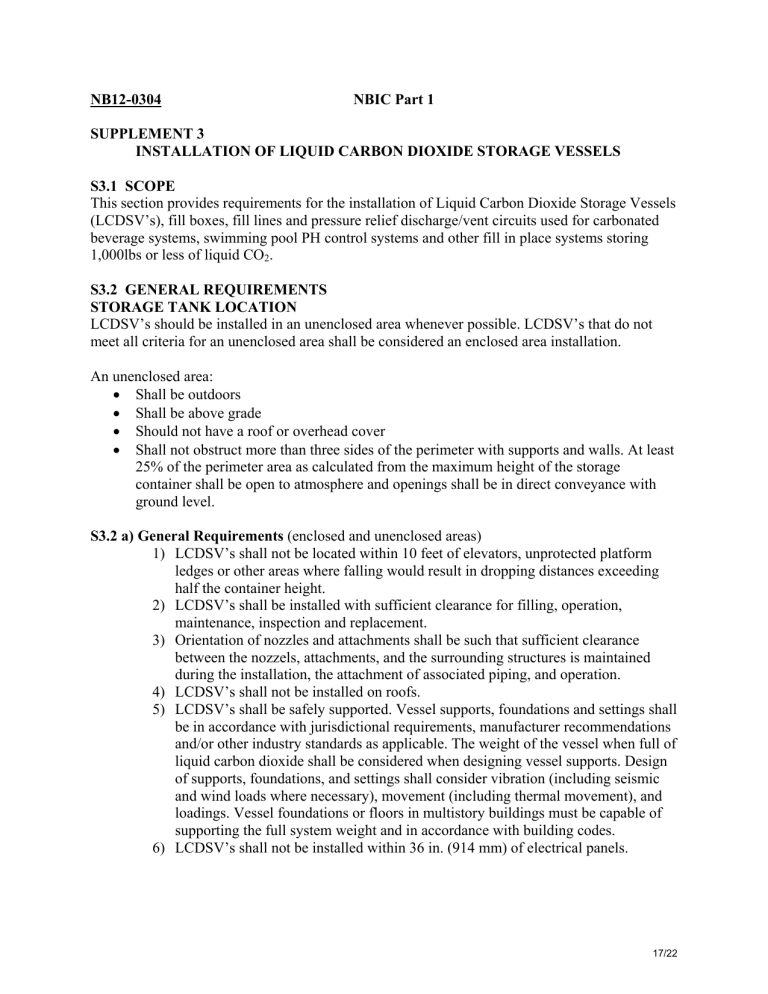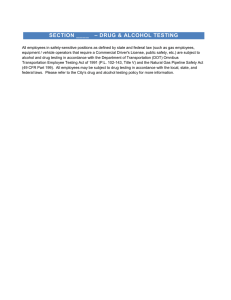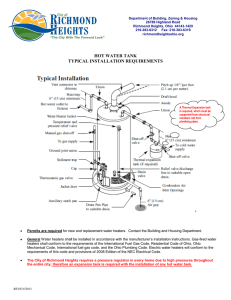Installation of Liquid Carbon Dioxide Storage Vessels

NB12-0304 NBIC Part 1
SUPPLEMENT 3
INSTALLATION OF LIQUID CARBON DIOXIDE STORAGE VESSELS
S3.1 SCOPE
This section provides requirements for the installation of Liquid Carbon Dioxide Storage Vessels
(LCDSV’s), fill boxes, fill lines and pressure relief discharge/vent circuits used for carbonated beverage systems, swimming pool PH control systems and other fill in place systems storing
1,000lbs or less of liquid CO
2
.
S3.2 GENERAL REQUIREMENTS
STORAGE TANK LOCATION
LCDSV’s should be installed in an unenclosed area whenever possible. LCDSV’s that do not meet all criteria for an unenclosed area shall be considered an enclosed area installation.
An unenclosed area:
Shall be outdoors
Shall be above grade
Should not have a roof or overhead cover
Shall not obstruct more than three sides of the perimeter with supports and walls. At least
25% of the perimeter area as calculated from the maximum height of the storage container shall be open to atmosphere and openings shall be in direct conveyance with ground level.
S3.2 a) General Requirements (enclosed and unenclosed areas)
1) LCDSV’s shall not be located within 10 feet of elevators, unprotected platform ledges or other areas where falling would result in dropping distances exceeding half the container height.
2) LCDSV’s shall be installed with sufficient clearance for filling, operation, maintenance, inspection and replacement.
3) Orientation of nozzles and attachments shall be such that sufficient clearance between the nozzels, attachments, and the surrounding structures is maintained during the installation, the attachment of associated piping, and operation.
4) LCDSV’s shall not be installed on roofs.
5) LCDSV’s shall be safely supported. Vessel supports, foundations and settings shall be in accordance with jurisdictional requirements, manufacturer recommendations and/or other industry standards as applicable. The weight of the vessel when full of liquid carbon dioxide shall be considered when designing vessel supports. Design of supports, foundations, and settings shall consider vibration (including seismic and wind loads where necessary), movement (including thermal movement), and loadings. Vessel foundations or floors in multistory buildings must be capable of supporting the full system weight and in accordance with building codes.
6) LCDSV’s shall not be installed within 36 in. (914 mm) of electrical panels.
17/22
7) LCDSV’s installed outdoors in areas in the vicinity of vehicular traffic shall be guarded to prevent accidental impact by vehicles. The guards or bollards shall be installed in accordance with local building codes or to a national recognized standard when no local building code exists.
8) LCDSV’s shall be equipped with isolation valves in accordance with paragraph
S3.6.
S3.2 b) Unenclosed area LCDSV installations.
If LCDSV’s are installed outdoors and exposed to the elements, appropriate additional protection may be provided as necessary based on the general weather conditions and temperatures that the tank may be exposed to. Some possible issues include: a.
Exposure to high solar heating loads will increase the net evaporation rate and will decrease hold times in low CO
2
usage applications. The vessel may be covered or shade provided to help reduce the solar load and increase the time needed to reach the relief valve setting in low use applications. b.
If supply line is not UV resistant then supply line should be protected via conduit or appropriate covering.
S3.2 c) Enclosed area LCDSV Installations
1) Permanent LCDSV installations with remote fill connections. a.
Shall be equipped with a gas detection system installed in accordance with paragraph S3.4 b.
Shall have signage posted in accordance with paragraph S3.5 c.
Shall be equipped with fill boxes; fill lines and safety relief/vent valve circuits installed in accordance with paragraph S3.6
2) Portable LCDSV installations with no permanent remote fill connection. Warning:
LCDSV’s shall not be filled indoors or in enclosed areas under any circumstances.
Tanks must always be moved to the outside to an unenclosed, free airflow area for filling. a.
Shall be equipped with a gas detection system installed in accordance with paragraph S3.4 b.
Shall have signage posted in accordance with paragraph S3.5 c.
Shall have safety relieve/vent valve circuit connected at all times except when the tank is being removed for filling. Connects may be fitted with quick disconnect fitting meeting the requirements of paragraph S3.6 d.
Shall be provided with a pathway that provides a smooth rolling surface to the outdoor, unenclosed fill area. There shall not be any stairs or other than minimal inclines in the pathway.
18/22
S3.3 FILL BOX LOCATION / SAFETY RELIEF/VENT VALVE CIRCUIT
TERMINATION
Fill boxes and/or vent valve terminations shall be installed above grade, outdoors in an unenclosed, free airflow area. The fill connection shall be located so not to impede means of egress or the operation of sidewalk cellar entrance doors, including during the delivery process and shall be: a) At least three (3) feet from any door or operable windows. b) At least three (3) feet above grade. c) Shall not be located within ten (10) feet from side to side at the same level or below, from any air intakes. d) Shall not be located within ten (10) feet from stair wells that go below grade.
S3.4 GAS DETECTION SYSTEMS
Rooms or areas where carbon dioxide storage vessel(s) are located indoors or in enclosed or below grade outdoor locations shall be provided with a gas detection and alarm system for general area monitoring that is capable of detecting and notifying building occupants of a CO
2 gas release. Alarms will be designed to activate a low level pre-alarm at 1.5% concentration of
CO
2
and a full high alarm at 3% concentration of CO
2
(which is the OSHA & ACGIH 15 minute and NIOSH 10 minute Short Term Exposure Limit for CO
2.
) These systems are not designed for employee personal exposure monitoring. Gas detection systems shall be installed and tested in accordance with manufactures installation instructions and the following requirements; a) Activation of the gas detection system shall activate an audible alarm within the room or area in which the carbon dioxide storage vessel is located. b) Audible alarms shall also be placed at the entrance(s) to the room or area where the carbon dioxide storage vessel and/ or fill box is located to notify anyone who might try to enter the area of a potential problem.
S3.5 SIGNAGE
Warning signs shall be posted at the entrance to the building, room, enclosure, or enclosed area where the container is located. The warning sign shall be at least 8 in (200mm) wide and 6 in
(150mm) high. The wording shall be concise and easy to read and the upper portion of the sign must be orange as shown in figure S3.5. The size of the lettering must be as large as possible for the intended viewing distance and in accordance with jurisdictional requirements. When no jurisdictional requirements exist, the minimum letter height shall be in accordance with NEMA
American National Standard for Environmental and Facility Safety Signs (ANSI Z535.2). The warning signs shall state the following:
19/22
“ WARNING – CARBON DIOXIDE GAS. Ventilate the area before entering. A high carbon dioxide ( CO
2
) gas concentration in this area can cause suffocation.”
Figure S3.5 a) Additional instruction signage shall be posted outside of the area where the container is located and such signage shall contain at minimum the following information;
Carbon Dioxide Monitors for general area monitoring (not employee personal exposure monitoring) are provided in this area. These monitors are set to alarm at 15,000ppm
(1.5% concentration) for the low level alarm and at 30,000ppm (3% concentration) for high level alarm.
Low Level Alarm (15,000ppm) – Provide appropriate cross ventilation to the area. Personnel may enter area for short periods of time (not to exceed 15 minutes at a time) in order to identify and repair potential leaks.
High Level Alarm (30,000ppm) – Personnel should evacuate the area and nobody should enter the affected area without proper self contained breathing apparatus until the area is adequately ventilated and the concentration of CO
2
is reduced below the high alarm limit.
S3.6 VALVES, PIPING, TUBING AND FITTINGS
Materials - Materials selected for valves, piping, tubing, hoses and fittings used in the LCDSV system shall meet following requirements: a) Components must be compatible for use with CO
2
in the phase, (gas, or liquid) it encounters in the system. b) Components shall be rated for the operational temperatures and pressures encountered in the applicable circuit of the system. c) Shall be stainless steel, copper, brass, or plastic/polymer materials rated for CO
2
.
20/22
d) Only fittings and connections recommended by the manufacturer shall be used for all hoses, tubes, and piping. e) All valves and fittings used on the LCDSV shall be rated for the maximum allowable working pressure stamped on the tank. f) All piping, hoses and tubing used in the LCDSV system shall be rated for the working pressure of the applicable circuit in the system and have a burst pressure rating of at least four times the maximum allowable working pressure of the piping, hose or tubing.
Relief Valves – Each LCDSV shall have at least one ASME stamped relief valve at or below the
MAWP of the tank. The relief valve shall be suitable for the temperatures and flows experienced during relief valve operation. The minimum relief valve capacity shall be designated by the manufacturer Additional relief valves that do not require ASME stamps may be added per CGA
S-1.3 recommendations. Discharge lines from the relief valves shall be sized in accordance with tables S3.6a & S3.6b Note: due to the design of the LCDSV the discharge line may be smaller in diameter than the relief valve outlet size.
Caution: Company’s and or individuals filling or refilling LCDSV’s shall be responsible for utilizing fill equipment that is acceptable to the manufacture to prevent over pressurization of the vessel.
Question - What is the ANSI number for CGA S-1.3?
Isolation Valves - Each LCDSV shall have an isolation valve installed on the fill line and tank discharge, or gas supply line in accordance with the following requirements: a) Isolation valves shall be located on the tank or at an accessible point as near to the storage tank as possible. b) All valves shall be designed or marked to indicate clearly whether it is open or closed. c) All valves shall be capable of being locked or tagged in the closed position for servicing. d) Gas Supply and Liquid CO
2
Fill Valves shall be clearly marked for easy identification.
Safety Relief/Vent LinesSafety relief/vent lines shall be as short and straight as possible with a continuous routing to an unenclosed area outside the building and installed in accordance with the manufacturer’s instructions. The vent line shall be a continuous run from PRD to outside vent line discharge fitting, without any splices. These lines shall be free of physical defects such as cracking or kinking and all connections shall be securely fastened to the LCDSV and the fill box. The minimum size and length of the lines shall be in accordance with table S3.6a and S3.6b.
Fittings or other connections may result in a localized reduction in diameter have been factored into the lengths given by the tables S3.6a and S3.6b.
21/22
Tank Size
(Pounds)
Fire Flow Rate
Requirements (Pounds per
Minute)
Maximum length of
3/8” ID Nominal
Metallic Tube Allowed
Maximum length of ½”
Metallic Tube Allowed
Less than 500 2.60 maximum 80’
55’
18’
100’
100’
100’ Over 750 to 5.51 maximum
1000
Table S3.6a Minimum LCDSV System Safety Relief/Vent Line Requirements (Metallic)
Tank Size
(Pounds)
Fire Flow Rate
Requirements (Pounds per Minute)
Maximum length of 3/8 ID plastic/polymer materials
Tube Allowed
Maximum length of ½ ID plastic/polymer materials
Tube Allowed
Less than 500 2.60 maximum
500-750 3.85
100’
100’
100’
100’
100’ Over 750 to
1000
5.51 maximum N/A (See ½” column)
Table S3.6b Minimum LCDSV System Safety Relief/Vent Line Requirements (plastic/polymer )
22/22

